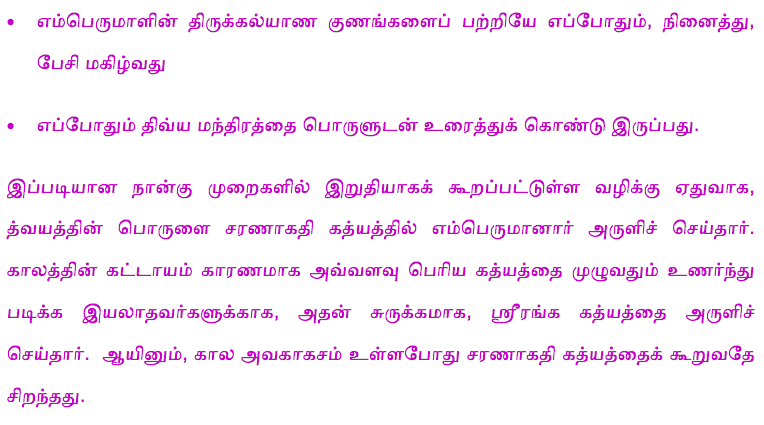
Bhagawan Sree Raamaanuja scripted this Sree Ranga gadhyam, known as “Mitha Gadhyam”, because of its shortness as compared to SaraNaagathy gadhyam, known as Pruthu gadhyam. As the words of “Sreerangasaayinam” appears at the end of the first stanza(ChoorNikai) and the sentence of “Sree Ranganaatha! Mama Naatha! NamOstutE” appears at the end of the gadhyam, this as a whole gets addressed to Lord Sree Ranganatha; this gadhyam is popularly acclaimed hence as Sree Ranga Gadhyam. Even in this short gadhyam, Sree BhaashyakArar has recalled the meaning and significance of the dhvaya mantram. Though the same is true of the bigger SaraNAgati gadhyam also, in order to meet the desire of His disciples for variety in phrases, Sree BhAshyakArar has given here thedhvayArtha (Meaning of dhvayam) in a summarized form
This gadhyam has five choorNikais (Stanzas) and two slOkas. The first stanzahas the meaning of the uttarabhAga (the second part) of the dhvaya mantram,while the second stanza contains the meaning of the PoorvabhAga(first part)of the dhvaya mantram as well as theadhikAri visEsham(Personal eligibility) and KaarpaNya(self-pity). The third stanza carries the significance of the
other requirements of Prapatti or SaraNAgati, in particular Mahaa Visvaasam. Two slokas follow this as the saastraic testimony or pramANa for the meanings of already adduced (tattvams). The next sentence (pankthi) proclaims the power of prapatti vaakya, the mere utterance of which fulfills the desire of self-surrender for even those who do not have the capability for the practise of poorNa prapatti, i.e. with full understanding of the preliminary requirements of “artha panchakam
- Aanukoolya sankalpam,
- Praatikoolya Varjanam,
- KaarpaNyam
- gOpthruva varaNam and
- Mahaa Vivaasam, then and then only AtmanivEdhanam or surrender of the self
















